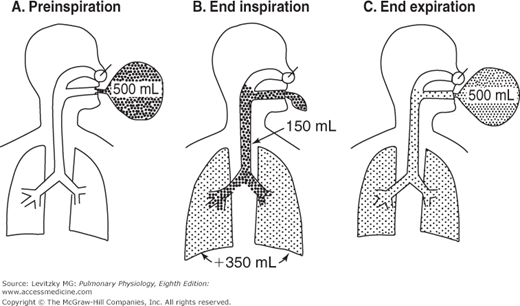

The objective of our physiology-based study is to evaluate the relationship between ETCO 2 and PaCO 2 across a wide range of Vd/Vt ratios. 24 The Vd/Vt of adult patients with acute lung injury is generally 0.40-0.55, and for those patients with acute respiratory distress syndrome (ARDS) a significantly elevated Vd/Vt is associated with increased mortality 25. The normal physiologic dead space to tidal volume ratio (Vd/Vt) is 0.20-0.35. In a patient with lung disease, the addition of alveolar dead space further dilutes ETCO 2 relative to PaCO 2. 20, 21, 22 Although typical alveolar CO 2 concentrations are slightly greater than that of arterial blood, ETCO 2 is normally 2-5 mm Hg lower than PaCO 2 23 due to mixing of CO 2-containing alveolar gas with exhaled gas devoid of carbon dioxide from the anatomical dead space. The gradient between ETCO 2 and PaCO 2 is directly proportional to the degree of physiologic dead space. Physiologic dead space ventilation is the sum of anatomical dead space from the conducting airways and alveolar dead space from disease processes and/or therapies employed.

The analyses utilized in these studies are highly variable and fail to consider physiologic dead space and/or its effect on the relationship between PaCO 2 and ETCO 2 as dead space increases. 13, 14, 15, 16, 17, 18, 19 However, many of these clinical situations involve patients with significant elevations in physiologic dead space. Critics of capnography reference multiple studies that conclude that ETCO 2 and PaCO 2 do not reliably correlate in some clinical situations. Advocates of capnography feel that end-tidal carbon dioxide (ETCO 2) may be used as a surrogate of arterial carbon dioxide (PaCO 2), which would provide a quick and noninvasive assessment of the adequacy of ventilation. There is less agreement about the utility of continuous capnography for ventilated intensive care unit patients 12. Capnography is also useful for monitoring the integrity of the ventilator circuit for early detection of mishaps such as inadvertent extubation 9, 10, 11.

Capnography is a useful monitoring tool during mechanical ventilation and is the standard of care for confirmation of endotracheal tube placement 1, 2, 3, 4, 5 and for monitoring in the operating room setting 6, 7, 8.


 0 kommentar(er)
0 kommentar(er)
